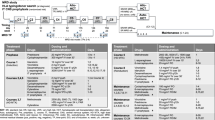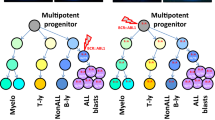Abstract
Acute lymphoblastic leukemia (ALL) in infants younger than 1 year is a rare but relatively homogeneous disease (∼80% MLL gene rearranged, ∼70% CD10-negative) when compared with childhood and adult ALL. Several studies in children and adults with ALL have shown that minimal residual disease (MRD) status is a strong and independent prognostic factor. We therefore evaluated the prognostic significance of MRD in infant ALL. Ninety-nine infant patients treated according to the Interfant-99 protocol were included in this study. MRD was analyzed by real-time quantitative PCR analysis of rearranged immunoglobulin genes, T-cell receptor genes and MLL genes at various time points (TP) during therapy. Higher MRD levels at the end of induction (TP2) and consolidation (TP3) were significantly associated with lower disease-free survival. Combined MRD information at TP2 and TP3 allowed recognition of three patients groups that significantly differed in outcome. All MRD-high-risk patients (MRD levels ⩾10−4 at TP3; 26% of patients) relapsed. MRD-low-risk patients (MRD level <10−4 at both TP2 and TP3) constituted 44% of patients and showed a relapse-rate of only 13%, whereas remaining patients (MRD-medium-risk patients; 30% of patients) had a relapse rate of 31%. Comparison between the current Interfant-06 stratification at diagnosis and the here presented MRD-based stratification showed that both stratifications recognized different subgroups of patients. These data indicate that MRD diagnostics has added value for recognition of risk groups in infant ALL and that MRD diagnostics can be used for treatment intervention in infant ALL as well.
This is a preview of subscription content, access via your institution
Access options
Subscribe to this journal
Receive 12 print issues and online access
$259.00 per year
only $21.58 per issue
Buy this article
- Purchase on Springer Link
- Instant access to full article PDF
Prices may be subject to local taxes which are calculated during checkout




Similar content being viewed by others
References
Biondi A, Cimino G, Pieters R, Pui CH . Biological and therapeutic aspects of infant leukemia. Blood 2000; 96: 24–33.
Armstrong SA, Staunton JE, Silverman LB, Pieters R, den Boer ML, Minden MD et al. MLL translocations specify a distinct gene expression profile that distinguishes a unique leukemia. Nat Genet 2002; 30: 41–47.
Jansen MW, Corral L, van der Velden VH, Panzer-Grumayer R, Schrappe M, Schrauder A et al. Immunobiological diversity in infant acute lymphoblastic leukemia is related to the occurrence and type of MLL gene rearrangement. Leukemia 2007; 21: 633–641.
Li A, Goldwasser MA, Zhou J, Armstrong SA, Wang H, Dalton V et al. Distinctive IGH gene segment usage and minimal residual disease detection in infant acute lymphoblastic leukaemias. Br J Haematol 2005; 131: 185–192.
Stam RW, den Boer ML, Pieters R . Towards targeted therapy for infant acute lymphoblastic leukaemia. Br J Haematol 2006; 132: 539–551.
Mann G, Cazzaniga G, van der Velden VH, Flohr T, Csinady E, Paganin M et al. Acute lymphoblastic leukemia with t(4;11) in children 1 year and older: the ‘big sister’ of the infant disease? Leukemia 2007; 21: 642–646.
Schrappe M, Reiter A, Zimmermann M, Harbott J, Ludwig WD, Henze G et al. Long-term results of four consecutive trials in childhood ALL performed by the ALL-BFM study group from 1981 to 1995. Berlin-Frankfurt-Munster. Leukemia 2000; 14: 2205–2222.
Pieters R, Schrappe M, De Lorenzo P, Hann I, De Rossi G, Felice M et al. A treatment protocol for infants younger than 1 year with acute lymphoblastic leukaemia (Interfant-99): an observational study and a multicentre randomised trial. Lancet 2007; 370: 240–250.
van Dongen JJM, Seriu T, Panzer-Grumayer ER, Biondi A, Pongers-Willemse MJ, Corral L et al. Prognostic value of minimal residual disease in acute lymphoblastic leukaemia in childhood. Lancet 1998; 352: 1731–1738.
Eckert C, Biondi A, Seeger K, Cazzaniga G, Hartmann R, Beyermann B et al. Prognostic value of minimal residual disease in relapsed childhood acute lymphoblastic leukaemia. Lancet 2001; 358: 1239–1241.
Goulden N, Bader P, Van Der Velden V, Moppett J, Schilham M, Masden HO et al. Minimal residual disease prior to stem cell transplant for childhood acute lymphoblastic leukaemia. Br J Haematol 2003; 122: 24–29.
Bruggemann M, Raff T, Flohr T, Gokbuget N, Nakao M, Droese J et al. Clinical significance of minimal residual disease quantification in adult patients with standard-risk acute lymphoblastic leukemia. Blood 2006; 107: 1116–1123.
van der Velden VHJ, Hochhaus A, Cazzaniga G, Szczepanski T, Gabert J, van Dongen JJM . Detection of minimal residual disease in hematologic malignancies by real-time quantitative PCR: principles, approaches, and laboratory aspects. Leukemia 2003; 17: 1013–1034.
Flohr T, Schrauder A, Cazzaniga G, Panzer-Grumayer R, van der Velden V, Fischer S et al. Minimal residual disease-directed risk stratification using real-time quantitative PCR analysis of immunoglobulin and T-cell receptor gene rearrangements in the international multicenter trial AIEOP-BFM ALL 2000 for childhood acute lymphoblastic leukemia. Leukemia 2008; 22: 771–782.
Coustan-Smith E, Behm FG, Sanchez J, Boyett JM, Hancock ML, Raimondi SC et al. Immunological detection of minimal residual disease in children with acute lymphoblastic leukaemia. Lancet 1998; 351: 550–554.
Burmeister T, Marschalek R, Schneider B, Meyer C, Gokbuget N, Schwartz S et al. Monitoring minimal residual disease by quantification of genomic chromosomal breakpoint sequences in acute leukemias with MLL aberrations. Leukemia 2006; 20: 451–457.
Meyer C, Kowarz E, Schneider B, Oehm C, Klingebiel T, Dingermann T et al. Genomic DNA of leukemic patients: target for clinical diagnosis of MLL rearrangements. Biotechnol J 2006; 1: 656–663.
Meyer C, Schneider B, Reichel M, Angermueller S, Strehl S, Schnittger S et al. Diagnostic tool for the identification of MLL rearrangements including unknown partner genes. Proc Natl Acad Sci USA 2005; 102: 449–454.
van Dongen JJM, Langerak AW, Bruggemann M, Evans PAS, Hummel M, Lavender FL et al. Design and standardization of PCR primers and protocols for detection of clonal immunogloulin and T-cell receptor gene recombinations in suspect lymphoproliferations. Leukemia 2003; 17: 2257–2317.
Szczepanski T, van der Velden VHJ, Hoogeveen PG, De Bie M, Jacobs DCH, Van Wering ER et al. V{delta}2-J{alpha} gene rearrangements are frequent in precursor-B-acute lymphoblastic leukemia but rare in normal lymphoid cells. Blood 2004; 103: 3798–3804.
Szczepanski T, Willemse MJ, van Wering ER, van Weerden JF, Kamps WA, van Dongen JJM . Precursor-B-ALL with D(H)-J(H) gene rearrangements have an immature immunogenotype with a high frequency of oligoclonality and hyperdiploidy of chromosome 14. Leukemia 2001; 15: 1415–1423.
Verhagen OJ, Willemse MJ, Breunis WB, Wijkhuijs AJ, Jacobs DC, Joosten SA et al. Application of germline IGH probes in real-time quantitative PCR for the detection of minimal residual disease in acute lymphoblastic leukemia. Leukemia 2000; 14: 1426–1435.
Pongers-Willemse MJ, Seriu T, Stolz F, d’Aniello E, Gameiro P, Pisa P et al. Primers and protocols for standardized detection of minimal residual disease in acute lymphoblastic leukemia using immunoglobulin and T cell receptor gene rearrangements and TAL1 deletions as PCR targets: report of the BIOMED-1 CONCERTED ACTION: investigation of minimal residual disease in acute leukemia. Leukemia 1999; 13: 110–118.
Bruggemann M, van der Velden VH, Raff T, Droese J, Ritgen M, Pott C et al. Rearranged T-cell receptor beta genes represent powerful targets for quantification of minimal residual disease in childhood and adult T-cell acute lymphoblastic leukemia. Leukemia 2004; 18: 709–719.
van der Velden VHJ, Wijkhuijs JM, Jacobs DC, van Wering ER, van Dongen JJM . T cell receptor gamma gene rearrangements as targets for detection of minimal residual disease in acute lymphoblastic leukemia by real-time quantitative PCR analysis. Leukemia 2002; 16: 1372–1380.
van der Velden VHJ, Willemse MJ, van der Schoot CE, Hahlen K, van Wering ER, van Dongen JJM . Immunoglobulin kappa deleting element rearrangements in precursor-B acute lymphoblastic leukemia are stable targets for detection of minimal residual disease by real-time quantitative PCR. Leukemia 2002; 16: 928–936.
van der Velden VH, de Bie M, van Wering ER, van Dongen JJ . Immunoglobulin light chain gene rearrangements in precursor-B-acute lymphoblastic leukemia: characteristics and applicability for the detection of minimal residual disease. Haematologica 2006; 91: 679–682.
Langer T, Metzler M, Reinhardt D, Viehmann S, Borkhardt A, Reichel M et al. Analysis of t(9;11) chromosomal breakpoint sequences in childhood acute leukemia: almost identical MLL breakpoints in therapy-related AML after treatment without etoposides. Genes Chromosomes Cancer 2003; 36: 393–401.
Metzler M, Brehm U, Langer T, Viehmann S, Borkhardt A, Stanulla M et al. Asymmetric multiplex-polymerase chain reaction - a high throughput method for detection and sequencing genomic fusion sites in t(4;11). Br J Haematol 2004; 124: 47–54.
Robinson BW, Slater DJ, Felix CA . BglII-based panhandle and reverse panhandle PCR approaches increase capability for cloning der(II) and der(other) genomic breakpoint junctions of MLL translocations. Genes Chromosomes Cancer 2006; 45: 740–753.
Reichel M, Gillert E, Angermuller S, Hensel JP, Heidel F, Lode M et al. Biased distribution of chromosomal breakpoints involving the MLL gene in infants versus children and adults with t(4;11) ALL. Oncogene 2001; 20: 2900–2907.
van der Velden VH, Cazzaniga G, Schrauder A, Hancock J, Bader P, Panzer-Grumayer ER et al. Analysis of minimal residual disease by Ig/TCR gene rearrangements: guidelines for interpretation of real-time quantitative PCR data. Leukemia 2007; 21: 604–611.
van der Velden VH, Panzer-Grumayer ER, Cazzaniga G, Flohr T, Sutton R, Schrauder A et al. Optimization of PCR-based minimal residual disease diagnostics for childhood acute lymphoblastic leukemia in a multi-center setting. Leukemia 2007; 21: 706–713.
Acknowledgements
We gratefully acknowledge Patricia Hoogeveen, Maaike de Bie, Susi Fischer, Eva Csinady, and Jessica Buijs-Gladdines for excellent technical assistance and Marieke Comans-Bitter for preparing the figures. We thank all clinicians of the collaborative group for taking and sending in patient samples. This study was supported by the Dutch Cancer Foundation (KWF Grant EUR2001-2441; MWJCJ, VHJvdV), Fondazione Città Della Speranza, Fondazione Cariparo, AIRC, Murst (ex 40%) (GB), ‘Österreichische Kinderkrebshilfe’, the Research Program ‘Genome Research for Health’ of the Austrian Ministry of Education, Science and Culture (GEN-AU Child, GZ 200.136/1-VI/1/2005), OENB 12213 (ERP-G), Wilhelm-Sander Foundation (MM), the Deutsche Krebshilfe (research grant 107819; RM), IBISCUS and AIRC (LLN), Fondazione Tettamanti, Fondazione Cariplo, AIRC and MIUR (GC). This study was performed on behalf of the Interfant-99 study group (coordinator: R Pieters), which is composed of AIEOP (G de Rossi, A Biondi; Italy), ANZCHOG (R Suppiah; Australia, New Zealand), Argentina (M Felice), BFM-A (G Mann; Austria), BFM-G (M Schrappe; Germany), COALL (G Janka-Schaub; Germany), CWPGH (J Stary; Czech Republic), DCOG (R Pieters; the Netherlands), DFCI consortium (L Silverman; USA), EORTC-CLCG (A Fester; France, Belgium, Portugal), FRALLE (F Mechinaud; France), Hong Kong (CK Li), NOPHO (L Hovi; Scandinavian countries), PINDA (M Campbell; Chile), PPLLSG (T Szczepañski; Poland), SJCRH (JE Rubnitz; USA), UKCCSG (I Hann, A Vora; United Kingdom).
Author information
Authors and Affiliations
Corresponding author
Additional information
The data reported in this manuscript are original, have not been published previously and have not been submitted for publication elsewhere.
Rights and permissions
About this article
Cite this article
Van der Velden, V., Corral, L., Valsecchi, M. et al. Prognostic significance of minimal residual disease in infants with acute lymphoblastic leukemia treated within the Interfant-99 protocol. Leukemia 23, 1073–1079 (2009). https://doi.org/10.1038/leu.2009.17
Received:
Accepted:
Published:
Issue Date:
DOI: https://doi.org/10.1038/leu.2009.17
Keywords
This article is cited by
-
Molecular characterization of TCF3::PBX1 chromosomal breakpoints in acute lymphoblastic leukemia and their use for measurable residual disease assessment
Scientific Reports (2023)
-
Evolution and optimization of therapies for acute lymphoblastic leukemia in infants
International Journal of Hematology (2023)
-
Proteasome inhibition targets the KMT2A transcriptional complex in acute lymphoblastic leukemia
Nature Communications (2023)
-
The KMT2A recombinome of acute leukemias in 2023
Leukemia (2023)
-
Measurable residual disease analysis in paediatric acute lymphoblastic leukaemia patients with ABL-class fusions
British Journal of Cancer (2022)



